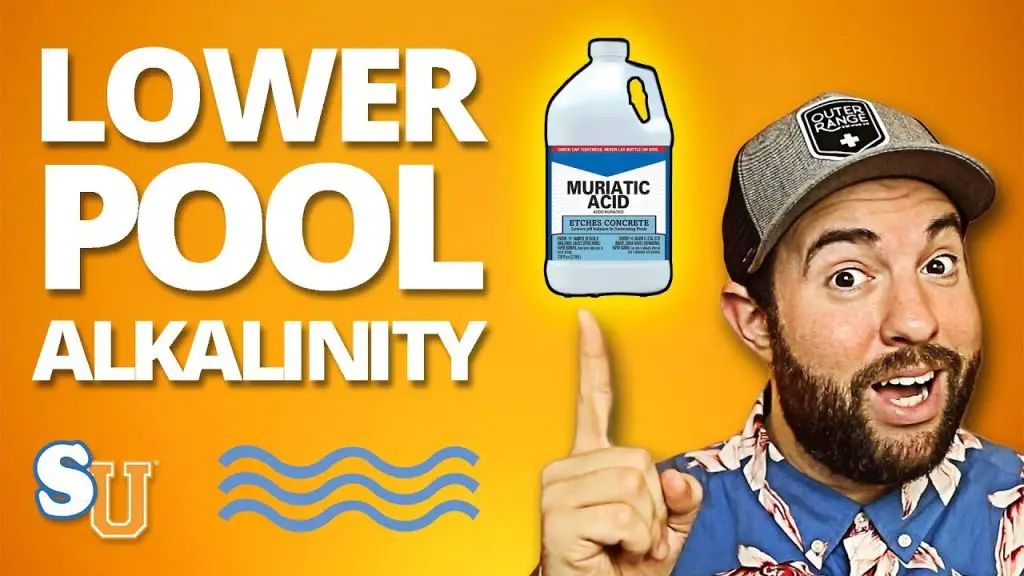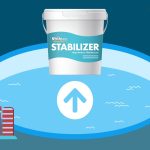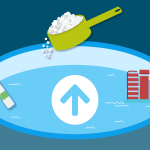To reduce alkalinity in your pool, balance the pH levels by adding muriatic acid in small increments and adjust the total alkalinity with sodium bisulfate or baking soda. This will ensure a well-maintained pool with proper chemical levels.
Lowering the alkalinity will help prevent cloudy water, scale formation, and pH fluctuation issues, creating a more comfortable swimming experience. Additionally, it’s important to monitor the pool’s alkalinity regularly and keep it within the recommended range to maintain water clarity and overall chemical balance.
By following these steps, you can easily reduce alkalinity and enjoy a clean and well-balanced pool.
Understanding Alkalinity In Pools
Understanding alkalinity in pools is crucial for pool maintenance. If you want to reduce alkalinity in your pool, consider using pH decreaser or muriatic acid to effectively balance the water chemistry. Regular testing and treatment can help maintain a clean and healthy swimming environment.
Understanding Alkalinity in Pools What is Pool Alkalinity? Pool alkalinity refers to the water’s ability to resist changes in pH levels. It acts as a buffer, preventing drastic fluctuations in acidity or basicity. Alkalinity mainly consists of bicarbonates, carbonates, and hydroxides. Maintaining the right balance is crucial for a safe and comfortable swimming environment. Importance of Alkalinity Levels 1. Prevents pH Fluctuations: Adequate alkalinity ensures the pool’s pH remains stable. This stability is essential for the effectiveness of sanitizers and the comfort of swimmers. 2. Protects Equipment: Proper alkalinity levels prevent corrosion of pool equipment such as pumps, filters, and heaters, prolonging their lifespan. 3. Enhances Water Clarity: Balanced alkalinity promotes clear water by allowing the pool’s filtration system to work efficiently, trapping impurities. 4. Comfortable Swimming Experience: Maintaining optimal alkalinity levels ensures that swimmers are not exposed to water that can cause skin and eye irritation. By understanding the significance of alkalinity and its impact on pool maintenance, you can effectively manage and enhance the swimming experience for all users.Common Signs Of High Alkalinity
High alkalinity in pools can cause several issues that indicate the need for a reduction in alkalinity. Here are the common signs of high alkalinity:
Cloudy Water
Cloudy water is a clear indication of high alkalinity. When the alkalinity levels are elevated, it can lead to the formation of small particles in the water, causing it to appear cloudy. This not only affects the water’s aesthetics but may also indicate potential health risks for swimmers.
Scale Build-up
Scale build-up on the pool surfaces is another tell-tale sign of high alkalinity. Elevated levels of alkalinity can lead to the formation of scale on the pool walls and equipment. This not only affects the overall appearance of the pool but can also result in costly damage to the pool infrastructure if left untreated.
Testing Pool Alkalinity
Using Test Strips
Test strips are a quick and easy way to check the alkalinity of your pool water. Dip the strip into the water and compare the color change to the provided chart.
Using Liquid Test Kits
Liquid test kits provide a more precise measurement of alkalinity levels in your pool. Follow the instructions carefully to obtain accurate results.

Credit: m.youtube.com
Proven Solutions For Lowering Alkalinity
Lowering the alkalinity in your pool is an essential step towards maintaining a healthy and balanced water chemistry. High alkalinity levels can lead to issues such as cloudy water, scaling, and difficulty in maintaining proper pH levels. Fortunately, there are proven solutions that can help you effectively lower alkalinity in your pool. In this article, we will explore two popular methods: adding muriatic acid and using pH decreaser products.
Adding Muriatic Acid
Muriatic acid, also known as hydrochloric acid, is a common and highly effective solution for reducing alkalinity in swimming pools. It is readily available at most pool supply stores and is relatively easy to use.
To add muriatic acid to your pool, follow these steps:
- Put on protective gloves and eyewear.
- Ensure the pool pump is running.
- Using a plastic container, slowly pour the muriatic acid directly into the pool water.
- Start with a small amount and test the water chemistry frequently to avoid overcorrection.
- Allow the acid to circulate for several hours before retesting and adding more if necessary.
It’s crucial to remember that muriatic acid is highly corrosive and should be handled with care. Always follow the manufacturer’s instructions and use the recommended safety precautions.
Using Ph Decreaser Products
If you prefer an alternative to muriatic acid, pH decreaser products are another effective option to reduce alkalinity in your pool. These products are specially formulated to lower pH and alkalinity levels.
Here are the steps to use pH decreaser products:
- Read and follow the instructions provided by the manufacturer.
- Calculate the necessary amount based on your pool size and current alkalinity levels.
- Dissolve the product in a bucket of water according to the instructions.
- Pour the solution evenly around the pool while the pump is running.
- Allow the product to circulate and retest the water after a few hours.
It’s essential to choose a high-quality pH decreaser product to ensure the best results. Always follow the manufacturer’s recommendations and use the recommended safety measures.
By incorporating these proven solutions into your pool maintenance routine, you can effectively reduce alkalinity and maintain a balanced and inviting swimming environment.
Precautions And Safety Measures
When reducing alkalinity in your pool, safety is paramount. Follow these precautions to ensure a safe process.
Wearing Protective Gear
Before starting the process, make sure to wear protective gear such as goggles and gloves.
Proper Dilution Procedures
Follow proper dilution procedures to avoid any risks of exposure or accidents.

Credit: waterguru.com
Utilizing Aeration Techniques
When it comes to maintaining a well-balanced pool, reducing alkalinity is a crucial step. One effective method to achieve this is by utilizing aeration techniques. Aeration involves introducing air into the pool water, which can help regulate pH levels and reduce alkalinity. In this article, we will explore How Aeration Helps Reduce Alkalinity and discuss Implementing Aeration Methods.
How Aeration Helps Reduce Alkalinity
Aeration is a valuable technique in reducing alkalinity levels in a pool. By introducing air into the water, aeration helps to break down excess carbon dioxide, which is a primary contributor to alkalinity. When carbon dioxide molecules react with the air, they form carbonic acid, which can then be released as carbon dioxide gas through the pool’s surface. This process naturally reduces the alkalinity of the water, ensuring a more balanced pool environment.
Implementing Aeration Methods
There are various methods available for implementing aeration in your pool to reduce alkalinity. Let’s explore some of these methods:
| Method | Description |
|---|---|
| Natural Air Circulation | Utilize the natural wind and currents to enhance air circulation in the pool. |
| Air Jets | Install air jets that release small bubbles into the pool, promoting aeration. |
| Air Stones | Place air stones at strategic locations in the pool to create small air bubbles. |
In addition to these methods, you can also consider utilizing a fountain or a waterfall feature to enhance the aeration process. The movement of water in these structures increases air exposure and helps in reducing alkalinity effectively.
Implementing regular aeration sessions is key to maintaining optimal pool conditions. Aim to schedule aeration sessions for at least 30 minutes per day or as recommended by a pool professional. Remember to monitor alkalinity levels regularly and adjust aeration methods accordingly to ensure desired results.
By understanding the benefits of aeration and implementing suitable methods, you can effectively reduce alkalinity in your pool, creating a more enjoyable swimming experience for everyone.
Regular Maintenance Practices
To decrease alkalinity in your pool, regular maintenance practices such as using muriatic acid or a pH decreaser can be effective. Testing the water frequently and adjusting the alkalinity levels accordingly helps prevent scaling and cloudy water. Consider adding an alkalinity reducer to keep your pool balanced and enjoyable for swimming.
Regular maintenance practices are crucial for keeping your pool in top condition. By monitoring levels frequently and balancing other chemicals, you can effectively reduce alkalinity in your pool.Monitoring Levels Frequently
Consistently monitoring the chemical levels in your pool is essential for effective maintenance. Test the pH and alkalinity levels every 2-3 days, especially during hot weather or after heavy pool usage. Use a reliable test kit to ensure accurate readings. Regular monitoring allows for timely adjustments, preventing imbalances that could lead to high alkalinity.Balancing Other Chemicals
In addition to monitoring alkalinity, it’s vital to maintain proper chlorine levels to prevent the accumulation of alkaline substances. Regularly shock the pool to remove organic compounds and contaminants that can contribute to increased alkalinity. Using a quality algaecide can also help in preventing the growth of algae, which can lead to higher alkalinity levels. Following these regular maintenance practices will enable you to effectively reduce the alkalinity in your pool, resulting in a balanced, safe, and enjoyable swimming environment.Seeking Professional Help
To effectively decrease the alkalinity levels in your pool, consider seeking professional assistance from experienced pool maintenance specialists. The expertise and knowledge of professionals can help accurately assess the alkalinity levels and recommend the right treatment methods to restore the balance, ensuring a safe and enjoyable swimming environment.
To effectively manage the alkalinity of your pool, it’s crucial to recognize when it’s time to seek professional help. The guidance of a pool expert can make a significant difference in maintaining your pool’s overall balance. Knowing when to consult a pool expert and understanding the professional services available for alkalinity adjustment can lead to a hassle-free and enjoyable pool experience that everyone can appreciate. When to Consult a Pool Expert You should consider consulting a pool expert if you observe persistent fluctuations in your pool’s alkalinity levels despite consistent maintenance efforts. Additionally, if you encounter difficulties in balancing the pool’s pH levels, it’s advisable to seek professional assistance. A professional inspection may also be necessary if you are dealing with persistent algae growth or cloudy water, which can be indicative of underlying alkalinity issues. Professional Services for Alkalinity Adjustment Pool professionals offer a range of services for alkalinity adjustment, including testing and analysis of the current alkalinity levels, chemical treatments for correcting imbalances, and guidance on proper maintenance procedures. These experts use specialized tools and equipment to accurately measure alkalinity levels and recommend professional-grade solutions to efficiently rectify any imbalances. By leveraging their expertise and resources, pool professionals can effectively address alkalinity issues, ensuring a safe and enjoyable swimming environment for all. In summary, professional assistance is essential when managing alkalinity in your pool. By recognizing the signs that indicate the need for expert intervention and understanding the range of professional services available for alkalinity adjustment, you can maintain a well-balanced pool with ease.
Credit: waterguru.com
Conclusion
Maintaining the right pH level is crucial for a clean pool. Remember to test and adjust regularly. With proper treatment methods, you can easily reduce alkalinity in the pool. Enjoy crystal-clear water and a refreshing swim all summer long. Prioritize pool maintenance for a safe and enjoyable swimming experience.





